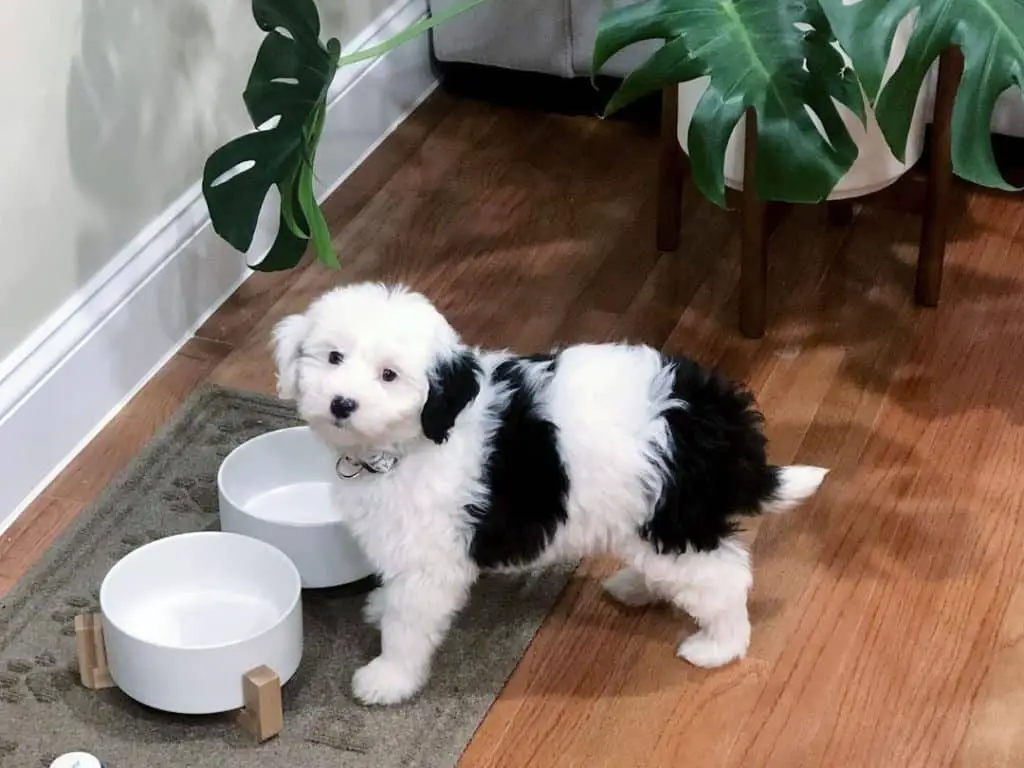Mini Sheepadoodles are irresistible because they’re little bundles of energy who are always ready for fun! Whether you’re out for an afternoon stroll or just sitting down at home, a mini sheepadoodle is always up for some playtime.
On top of that, they are just as fluffy and cuddly as their full-sized counterparts, and they are perfect if you love dogs but want something a little more manageable.
Playful, cuddly, non-aggressive, and loyal cross between an Old English Sheepdog and a Miniature Poodle, how can you say no?

Quick Facts: Mini Sheepadoodle
Height
15 - 18 inchesWeight
15 - 35 poundsLifespan
12 - 15 yearsBreed Size
small (0-25 lbs.)Breed Type
hybridBreed Group
companion, toyTemperament
friendly, gentle, playfulGood With
families, other dogs, cats, strangersIntelligence
highShedding
infrequentExercise Needs
highBarking Level
lowEnergy level
highDrool Amount
lowCoat Type
medium length, wavyCoat Patterns
bi-colorColors
black, brown/chocolate, cream, gray, whiteOther Characteristics
apartment-friendly, cold weather tolerant, easy to groom, easy to train, good for first-time pet owners, good hiking companion, hot weather tolerant, hypoallergenic, prone to health issues, strong loyalty tendenciesMini Sheepadoodle Highlights
- It is a mixed breed, an offspring of a Miniature Poodle and an Old English Sheepdog. Both these breeds have had a long history as valuable companions. The Old English Sheep Dog is known as a herding dog, and the Poodle is known as a bird hunter.
- Mini Sheepadoodle weights between 15-35 pounds, making them an ideal breed for older people who may not want to handle a large dog or for families with young kids who don’t want a giant pet.
- Because Mini Sheepadoodles are born with the minimal shedding characteristic of the Poodle breed, they’re likely to be as low-shedding as possible.
- They’re small enough to carry around everywhere and easy to pick up and take for walks, baths, or trips.
- They definitely fulfill their initial purpose of companionship by being extremely loyal and devoted to their owners – usually staying close to them throughout the day.
- Mini Sheepadoodles demand your time and energy more than their standard counterparts.
- Mini Sheepadoodles enjoy cuddling up next to you on the sofa just as much as they’d enjoy taking a stroll outdoors.
- Mini Sheepadoodle puppies usually come out with a combination of black (or dark brown) and white colors. Over their lifetime, the black color may fade to various grays, and a trait often inherited from the Old English Sheepdog. Some black spots may clear up completely, leaving them looking pure white.
- They are fine living with other dogs in the house. They are naturally intelligent and friendly, so they will enjoy the company of others.
History
For years the average American household was drawn to lovable dogs like the golden retriever and labrador retriever. But as anyone with one of these breeds knows, they shed a lot! So often, their fur would end up everywhere in your house, leaving it hard to clean. Also, these dogs can cause allergic reactions in people, and if someone in your household has a dog allergy, these breeds are not an ideal choice.
Breeders searched for a way to solve the problem of excessive shedding and allergic reactions. They found their answer in designer dogs, which combine two breeds already well known for their friendly personalities and low shedding rates. In this case, Mini Sheepadoodle is a mix between Old English Sheepdog and Miniature Poodle.
Perhaps best known for their shaggy coat, Old English Sheepdogs date back to the late 1800s. These dogs have dark brown, blue or black eyes and move like bears. They’re well regarded by children and can serve as watchdogs.
The other parent breed, Poodle, can be found in a miniature size. With curly hair for a coat, they do not shed much and are suitable for people who suffer allergies to dogs.
Even though the Mini Sheepadoodle started as a designer breed, some have ended up in shelters or at the hands of rescue groups.
Appearance
The Mini Sheepadoodle tends towards one parent or the other—some will have more of the square head of an old English Sheepdog, and others will have more of the dome head of a Minature Poodle. However, nearly all Mini Sheepadoodle share the patchy pattern of black and white markings, which often gives them the impression of a Panda. Sometimes these black and white markings can fade to gray. Rarely, they may be white and red.
Like most poodle mixes, their coats may tend more towards straight or more curly. Unfortunately, it’s usually tricky to determine which type of curl they will get until the dog grows up.
We’ll further discuss these aspects in the coat section below.
Size
They are available in different sizes, depending on the breeder. Some breeders call them micro sheepadoodles, usually smaller ones, but some breeders use the terms micro and mini synonymously. Nevertheless, they are smaller in size than the standard Sheepadoodles.
Generally, Mini Sheepadoodles are between 15 and 35 pounds and stand about 15 to 18 inches tall. They’re just average estimates; however, you should check with the breeder in your area to get accurate measurements for the pups. While breeders cannot guarantee an exact size, they can provide an estimate based on the weight and height of the Old English Sheepdog and Miniature Poodle parents.
Some breeders provide insight into the rapid developments that Mini Sheepadoodle pups experience from birth until they reach maturity. Accordingly, the growth rate for Mini Sheepadoodle pups slows down after they get 7 or 8 months old.
Colors
Mini Sheepadoodle puppies usually come out with a combination of black/white colorings. Over their lifetime, the black may fade to various grays; a trait often inherited from their Old English Sheepdog parent. Some black markings may clear up completely, leaving them pure white.
Some Mini Sheepadoodles can look completely different when grown up than they did as puppies. Others retain their original color patterns and markings throughout life.
Each Mini Sheepadoodle puppy has its own coat pattern, which includes black markings in the form of masks, parts, patches, polka dot markings, abstract spots, tuxedos, etc. There’s always a large range of variety in each breed. It is also possible to get puppies with shades of cream, brown, or red, but this is rare.
Coat
Mini Sheepadoodles puppies often come in curly or straight coats; however, it’s usually challenging to determine which type they’re going to have before they get older.
They’re a good option for people who suffer from allergies because they don’t shed at all. However, you’ll need to groom them roughly every 8 weeks and brush them 2-3 times weekly to keep their coat clean.
Because of their long coats, Mini Sheepadoodles can withstand colder temperatures better. They can also better stand up to warmer temperatures when their coats are kept short.
Personality
When combining the Miniature Poodle with the Old English Sheepdog breeds, you can be confident you’re getting an active and wonderful furry friend! Poodle and Old English Sheepdogs have lots of energy, love being around humans, and are generally happy dogs. However, both breeds also require plenty of exercise and attention.

They’ll get along with any family member, but they may not do so well if they feel neglected. Also, because they’re so needy, it’s hard to leave them at home alone for long periods.
Despite its size, the Mini Sheepadoole are definitely up for loads of fun. If you’re looking for a smaller dog who can keep up with you on longer adventures, check out the Mini Sheepadoodle. They’re small enough to be easily carried around but big enough to enjoy lots of fun and adventure!
Moreover, Mini Sheepadoodle puppies can be quite boisterous and may require training at an early stage. However, both parent breeds are considered highly intelligent, so the offspring is easy to train. They’re responsive to positive reinforcement and treats and enjoy learning new things. Tricks are also great fun for these obedient pups, who’ll learn them quickly.
Many Mini Sheepadoodles have become very loyal companions and excellent therapy and emotional support dogs for people of all ages. They’re easygoing and adaptable, making them perfect for families of all sizes. And even though they are friendly and loyal to humans, they will be excellent guard dogs for their homes.
Health
They’re usually healthy, but like their parents, they can inherit health issues from them. So it’s crucial to take good care of these dogs and keep up with regular vet visits.
Common health issues for Mini Sheepadoodles include:
Ear Infections: Floppy ears are cute, but they do make dogs susceptible to ear infections. These infections can be caused by various factors including excessive water intake, poor hygiene, and bacterial buildup. Because of their floppy ears, Mini Sheepadoodles are especially vulnerable to these problems.
Fortunately, out of all Mini Sheepadoodles’ health issues, this one has the lowest treatment cost compared to others, ranging from $100-$250.
Optic Nerve Hypoplasia (ONH): Optic nerve hypoplasia is an eye condition that can affect Mini Sheepadoodles. Symptoms of ONH typically develop in young Mini Sheepadoodles between the ages of two and four months.
They may experience difficulty seeing in one or both of their eyes, and may have reduced vision in that eye. If left untreated, the condition can lead to complete blindness.
If you suspect your Mini Sheepadoodle might be experiencing ONH, consult your vet. Your vet can conduct an exam and test your puppy’s eyesight to see if he or she suffers from onh. If your puppy does suffer from ONH, you’ll need to take certain measures to help them recover.
Hip Dysplasia: A common orthopedic issue for Mini Sheepadoodle puppies is called hips dysplasia. This inherited condition causes the hips to be poorly formed. Over time, this can cause friction and wear down the joints, leading to pain and reduced mobility.
The most common treatment options for hip dysplasia include corrective surgeries, which can cost anywhere between $7,000-$13,000. Other treatments include pain relief, exercise, and dietary changes.
Addison’s Disease: Hypoadrenocorticism, also known as Addison’s Disease, tends to affect Mini Sheepapoodles more often than other breeds. It affects the outer layer of one of the adrenal glands, which basically means that it gets destroyed. Although it‘s a small organ, it can affect the dog’s health in various ways, including regulating the metabolism and supporting the immune systems.
This condition usually starts out as a minor problem, but if left untreated, it can become life threatening. It’s characterized by low blood pressures, low blood sugars, and high amounts of sodium (which causes water retention).
Sebaceous Adenitis: Sebaceous adenitiis is a common skin problem in Mini Sheepadoodles, so we’re going to tell you about it. It’s not too expensive to treat, but it requires frequent use of an antibacterial product and regular shampooing.
It is an an immune-mediate disorder in which there is inflammation of the sebaceous glands. These glands are located near the hair follicles and secrete substances that help to maintain the health of the coat. Two types of sebaceous adenopathy exist — those affecting only short-haired dogs and those affecting only long-haired dogs.
Corneal Dystrophy: Corneal dystrophies are terms used to describe various eye diseases that affect the cornea.
There are three main types: epithelial, stromal, and endothelial. These three types of corneal dystrophies are distinguished by their anatomical location in the cornea and the clinical signs they cause.
So there you have it- the common health issues associated with Mini Sheepadoodles.
One advantage to properly bred Mini Sheepadoodles is that the likelihood of health conditions that may be more prone to their parents can be reduced through crossbreeding.
For example, some rare health conditions can be inherited from one parent but not the other. If both parents carry these traits, then their offspring could inherit them. However, if the parent dogs don’t share these traits, then the chances of passing them down to their puppies are greatly diminished.
Crossing two healthy, pure-bred dogs from different breeds increase the chances that any genetic defects will be eliminated. However, this doesn’t mean that these dogs are immune to health concerns.
With advanced age, any dog could become ill. However, regular veterinary care combined with good nutrition and regular physical activity will help a Mini Sheepadoodle live a long, happy, healthy, and active lifestyle.
Lifespan
Contrary to popular belief, not every size of Sheepadoodle has the same lifespan. Some live longer than others, depending on their age, weight, level of physical activity, type of living environment, and diet.
Overall, Mini Shepadoodles have a life expectancy of 15 years, which means they will be a loyal member of the family for at least a decade.
Care
Like all dogs, you should regularly visit your veterinarian for regular veterinary visits to ensure that your Mini Sheepadoodle stays healthy. A veterinarian can advise on developing a routine that best suits your Mini Sheepadoodle.
To keep your Mini Sheppadoodle fit and happy, they must get plenty of daily physical activity. In addition, making sure your dog has enough physical activity to stay healthy will help to protect their joint health as they grow older.
To avoid Mini Sheepadoodles from becoming destructive due to boredom, they must be given plenty of mental stimulation.
Check their floppy ears if they have any kind of ear infection. Clean them as recommended by your veterinarian. Trim your dog’s nails before they get too far down. Usually, you only need to trim them once or twice a month.
If your pet doesn’t seem to mind having its teeth brushed, then it’s a good idea to brush it regularly. You can learn from your veterinarian how to do so correctly and which toothpaste to use.
Diet

Mini Sheepadoodles tend to overeat and get fat, so you should limit the number of treats they receive and ensure that they don’t engage in strenuous activity after eating.
Most commercial dog foods come with a feeding guide on the packaging, which will tell you how much to feed per day for different activity levels. If you’re feeding raw, you’ll need to know their weights to calculate how much they eat daily.
Dry vs Raw Food
If you’re looking for a quick and easy way to feed your Mini Sheepadoodle, dried and canned foods offer a convenient solution. All you need to do is open the package, measure the appropriate amount, and feed your pet. It couldn’t be easier!
On the other hand, raw food takes some effort to prepare, but feeding your dog raw food tends to be healthier in the long run. Many experts recommend that your dog’s food consists of meat, bones, vegetables, organs, nuts and fruits.
Grooming
Because Mini Sheepadoodles shed less than most other breeds, you’re likely to spend less time cleaning up after them. However, because they shed less than most other dogs, they may require more frequent brushing to keep their coats looking good.
To keep your dog looking their best, brush them at least three days a week if you want them to be completely smooth. We recommend using both a de-matter brush and a regular hairbrush to work through their entire coats.
Furthermore, Mini Sheepadoodles need regular grooming to maintain their coats, trim their nails, and remove any mats or matted fur. They can also develop ear infections if not kept clean. You can either learn to groom them yourself, or, as most owners do, you can bring your Mini Sheepadoodle to the groomer.
Children And Other Pets
Mini Sheepadoodles are naturally playful and friendly towards people and other dogs. Children often fall in love with them because of their fluffy appearance. So don’t be surprised when your children find a new best friend.
If you’re not aware, Old English Sheepdogs are bred to herd sheep; they can be a dog that nips kids. A nip isn’t an attack; it’s simply a gentle way for a dog to get a person’s attention. It’s not meant to hurt them.
Some Mini Sheepadoodles can pick up this tendency while still a pup under two years old. Parents with young children should understand this behavior and work closely with their veterinarian or dog trainer to ensure their puppy receives regular obedience classes and socialization sessions.
Because these dogs have a strong desire to be liked by their owners, they should quickly learn that acting this way makes them less likely to get positive attention from their owners. They will stop doing this with proper guidance because they want to make you happy.
Despite their nipping tendencies, Mini Sheepadoodles are pretty easygoing and don’t mind playing with young children. They love to burn off energy by running around.
Mini Sheepadoodles are also very friendly towards other pets and can easily adjust to living with others. They are happy to go outside and visit dog parks and will make friends quickly if given a chance. Two or more Mini Sheepadoodles in one household works best, as they will bond together and protect each other.
Mini Sheepadoodle FAQs
How big will a Mini Sheepadoodle get?
They are usually between 15 and 35 pounds, and they typically reach an average height of 15 to 18 inches.
Are Mini Sheepadoodles good pets?
Yes. They are playful, social, and easy to care for. They are also loving and gentle, making them perfect for families with small children.
What is the price of a Mini Sheepadoodle?
Most Mini Sheepadoodle puppies will cost between $1,000 and 3,000 dollars.
Do Mini Sheepadoodles bark a lot?
These gentle little guys don’t bark a lot even when meeting new people and new dogs.
Are Mini Sheepadoodles aggressive?
No. These dogs are friendly with everyone they meet and rarely show signs of aggression.
Rescue Groups
You might not be able to find a Mini Sheepadoodle specific shelter, but you could look into Old English Sheepdogs or Poodles, which tend to take in mixes. Here are some rescuers you can check out:
Somerset Cottage Poodle Rescue
Oodles of Doodles Rescue Collective
Michigan Doodle Rescue Connect
Old English Sheepdog Rescue Network
Mini Sheepadoodle Fun Facts
- When Olympic figure skater Meryl Davis and her husband Fedor Andreev announced that they adopted their first dog, a Mini Sheepadoodle, people wanted one as well.
- Empathetic to human emotions and generous with its affections, the breed is an amazing therapy dog. One such example is Zammy, who works as a kids’ hospital therapeutic animal. His cute behavior has earned him widespread popularity on social networks.
- Mini Sheepadoodles don’t bark excessively, they will typically only bark for a reason.
References
Becker, D., Niggel, J. K., Pearce‐Kelling, S., Riis, R. C., & Aguirre, G. D. (2020). Optic nerve hypoplasia in miniature poodle dogs: A preliminary genetic and candidate gene association study. Veterinary ophthalmology, 23(1), 67-76.
Lathan, P., & Thompson, A. L. (2018). Management of hypoadrenocorticism (Addison’s disease) in dogs. Veterinary Medicine: Research and Reports, 9, 1.
Pye, C. (2021). Canine sebaceous adenitis. The Canadian Veterinary Journal, 62(3), 293.
Cooley, P. L., & Dice II, P. F. (1990). Corneal dystrophy in the dog and cat. Veterinary Clinics of North America: Small Animal Practice, 20(3), 681-692.
Leonard, B. C., Kermanian, C. S., Michalak, S. R., Kass, P. H., Hollingsworth, S. R., Good, K. L., … & Thomasy, S. M. (2021). A Retrospective Study of Corneal Endothelial Dystrophy in Dogs (1991–2014). Cornea, 40(5), 578.




